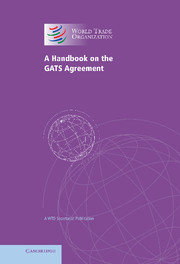Book contents
- Frontmatter
- Contents
- Preface
- Introduction
- 1 Basic purpose and concepts
- 2 Main building blocks: agreement, annexes and schedules
- 3 A closer look at domestic regulation
- 4 How the GATS is administered
- 5 The role and responsibilities of Member governments
- 6 The challenges ahead
- 7 Preparing requests and offers
- 8 Misconceptions about the GATS
- Appendix 1 Understanding your country's services trade
- Appendix 2 Relevant services statistics and classifications
- Annex: General Agreement on Trade in Services
- Index
3 - A closer look at domestic regulation
Published online by Cambridge University Press: 07 October 2011
- Frontmatter
- Contents
- Preface
- Introduction
- 1 Basic purpose and concepts
- 2 Main building blocks: agreement, annexes and schedules
- 3 A closer look at domestic regulation
- 4 How the GATS is administered
- 5 The role and responsibilities of Member governments
- 6 The challenges ahead
- 7 Preparing requests and offers
- 8 Misconceptions about the GATS
- Appendix 1 Understanding your country's services trade
- Appendix 2 Relevant services statistics and classifications
- Annex: General Agreement on Trade in Services
- Index
Summary
PURPOSE AND EFFECTS OF REGULATION
As noted before, the GATS makes a clear distinction between domestic regulation and measures subject to trade liberalization. On the one hand, it explicitly recognizes the continued right (and, possibly, the need) of Members to enforce domestic policy objectives through regulation. On the other hand, it promotes the objective of progressive liberalization, consisting of expanding and/or improving existing commitments on market access and national treatment.
Effective regulation – or re-regulation – can be a precondition for liberalization to produce the expected efficiency gains without compromising on quality and other policy objectives. For example, the opening of a hitherto restricted market may need to be accompanied by the introduction of new licensing mechanisms and public service obligations for quality and social policy reasons. Since many services contracts involve customized, not yet existing products (medical intervention, legal advice, etc.), the need for regulatory protection is particularly evident.
By the same token, however, it may be necessary to ensure that the benefits from liberalization are not frustrated by ineffective or inconsistent regulation. Many regulatory regimes have evolved in response to immediate problems and challenges, without much thought being given to trade and efficiency considerations. Moreover, regulatory responsibilities tend to be spread across ministries and agencies (Finance, Justice, Construction, Transport, Health, Education, etc.) and levels of government without much communication, let alone co-ordination.
- Type
- Chapter
- Information
- A Handbook on the GATS AgreementA WTO Secretariat Publication, pp. 21 - 25Publisher: Cambridge University PressPrint publication year: 2005

